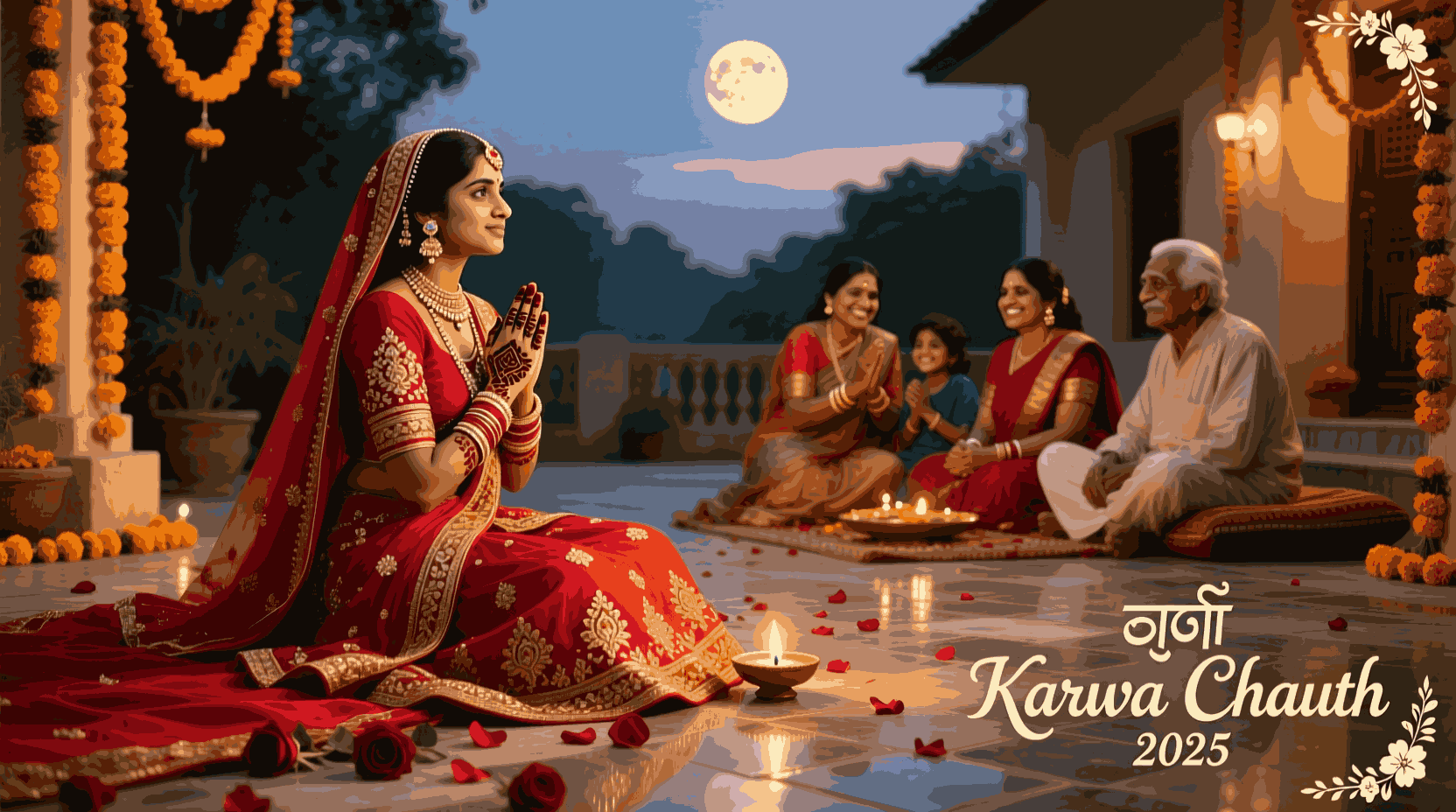Karwa Chauth 2025
The Sacred Festival of Love, Devotion, and Marital Bliss
When is Karwa Chauth 2025?
Karwa Chauth 2025 will be celebrated on Friday, October 10, 2025. This sacred festival falls on the Krishna Paksha Chaturthi (fourth day of the waning moon) in the Hindu month of Kartik. The festival is observed primarily by married Hindu women who fast from sunrise to moonrise for the longevity and well-being of their husbands.
The confusion around whether Karwa Chauth falls on October 9 or 10 arises from the lunar calendar calculations. According to Drik Panchang, the Chaturthi Tithi begins at 10:54 PM on October 9 and ends at 7:38 PM on October 10, making October 10 the correct date for observation.
Significance and Spiritual Meaning
Karwa Chauth holds profound significance in Hindu culture as it symbolizes the eternal bond of love and devotion between husband and wife. The festival represents:
- Marital Devotion: The nirjala fast (without food and water) demonstrates a wife’s love and commitment to her husband’s well-being
- Spiritual Discipline: The rigorous fasting period tests one’s willpower and spiritual strength
- Community Bonding: Women gather together, strengthening social ties and cultural traditions
- Family Unity: The festival brings families together, with mothers-in-law preparing Sargi and blessing their daughters-in-law
The Legend of Queen Veeravati
The most popular legend associated with Karwa Chauth tells the story of Queen Veeravati, who observed her first Karwa Chauth fast with great devotion. Her seven brothers, unable to see their sister starving, created a mirror illusion of the moon. Believing the moon had risen, Veeravati broke her fast prematurely, only to learn of her husband’s sudden illness. Heartbroken, she prayed fervently to Goddess Parvati, who revealed the deception. Veeravati then observed the fast with full dedication, and her husband was miraculously restored to health, symbolizing the power of true devotion.
Complete Rituals and Procedures
Sargi – The Pre-Dawn Meal
The day begins before sunrise with Sargi, a nutritious meal prepared by the mother-in-law. This meal typically includes fruits, sweets, dry fruits, milk, and light dishes to sustain energy throughout the day-long fast. Eating Sargi is both a practical necessity and a symbolic blessing from the elder generation.
Sankalp – Taking the Vow
After the pre-dawn meal, women take a sacred vow (Sankalp) to observe the fast with complete dedication. They recite specific mantras and pray for their husband’s long life, prosperity, and good health while promising to maintain the fast until moonrise.
Dressing and Adornment
Women dress in their finest traditional attire, preferably in auspicious colors like red, maroon, or pink. They apply beautiful mehndi (henna) designs on their hands and feet, wear jewelry, sindoor (vermillion), and bangles – all symbols of marital bliss and good fortune.
Evening Puja Ceremony
Before sunset, women gather for the evening puja. They worship Goddess Parvati, Lord Shiva, Lord Ganesha, and Karwa Mata. The Karwa Chauth Katha (story) is narrated, and women pass around decorated thalis containing diyas, flowers, sweets, and the sacred Karwa (earthen pot).
Moon Sighting and Arghya
When the moon rises, women view it through a sieve or veil, offer Arghya (water offering) to the moon god, and then look at their husband’s face through the same sieve. This ritual symbolizes filtering out negativity and bringing prosperity to the marital relationship.
Breaking the Fast
The husband offers water and the first morsel of food to his wife, officially breaking her day-long fast. This intimate moment represents mutual love, care, and the sacred bond between partners, followed by a celebratory meal with family.
Modern Celebrations and Trends
In recent years, Karwa Chauth has evolved to accommodate modern lifestyles while maintaining its traditional essence:
Contemporary Adaptations
Couples Fasting Together: Many modern couples now observe the fast together, reflecting partnership and mutual support in contemporary relationships. This trend has gained popularity among urban couples who view the festival as a celebration of their bond rather than just a traditional obligation.
Digital Celebrations: With families often living apart, virtual Karwa Chauth celebrations have become common. Women connect through video calls, share their mehndi designs on social media, and participate in online puja ceremonies, keeping traditions alive across distances.
Health-Conscious Approaches: Modern women are adopting healthier versions of the Sargi meal, including protein-rich foods, nuts, and fruits that provide sustained energy. Some also consult nutritionists to ensure the fast doesn’t negatively impact their health.
Commercial Impact
The festival has significant commercial importance, with markets bustling with activity. Sales of traditional attire, jewelry, mehndi cones, decorative items, and sweets see a substantial increase. Beauty parlors and mehndi artists experience high demand, and online platforms offer special Karwa Chauth collections and gift packages.
Astrological Significance
Karwa Chauth is deeply connected to astrological beliefs and lunar cycles. The festival occurs during the Krishna Paksha (waning moon phase) of Kartik month, which is considered highly auspicious for spiritual practices and marital blessings.
The moon plays a crucial role in the festival’s timing and rituals. According to Vedic astrology, the moon represents emotions, mind, and feminine energy. By observing the fast until moonrise, women align themselves with these cosmic energies, seeking blessings for harmony and longevity in their marital relationships.
The timing of Karwa Chauth is calculated based on the Chaturthi Tithi (fourth lunar day), which is associated with Lord Ganesha, the remover of obstacles. This timing is believed to be particularly powerful for overcoming challenges in relationships and ensuring marital happiness.



